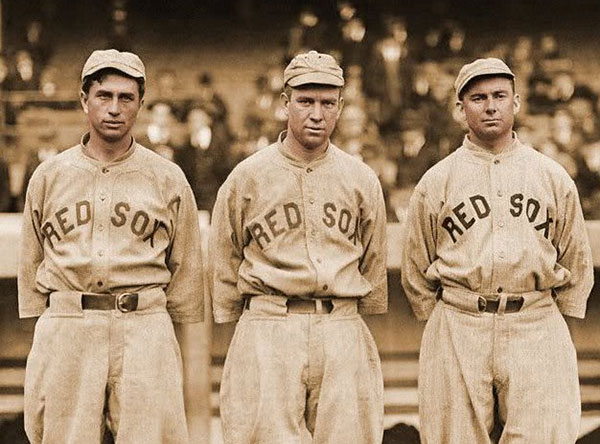Down to Read Today’s Essay
Subscribe to Baseball History Comes Alive for automatic updates. As a Free Bonus, you’ll get instant access to my Special Report: Gary’s Handy Dandy World Series Reference Guide!
Golden Outfield Photo Gallery
Click on any image below to see photos in full size and to start Photo Gallery:
The Red Sox’ “Golden Outfield!”
“They were the greatest defensive outfield I ever saw. They were smart and fast. They covered every square inch of the park. They could move into another country if the ball happened to fall there.” –Grantland Rice, speaking of the Golden Outfield
Most of us are familiar with the Philadelphia Athletics’ “$100,000 Infield” of Home Run Baker, Jack Barry, Eddie Collins, and Stuffy McInnes, but how about some equal time for the “Golden Outfield”?
The three great Red Sox were Duffy Lewis in left, Tris Speaker in center, and Harry Hooper in right, seen in the featured photo below. They played together from 1910-1915, which included two World Series championships (1912 and ’15). Ty Cobb and Babe Ruth both said the Golden Outfield was the best they had ever seen. The Golden Outfield was broken up when Speaker was traded to the Indians before the 1916 season after a salary dispute with Red Sox owner Joseph Lannin. Here’s a few words about each of their careers:
Tris Speaker
Speaker was the star center fielder of the Golden Outfield and was certainly one of the greatest players in major league history. For his career, Speaker hit .345, with 3,515 hits, 792 doubles (the major league record) and 1,529 RBI. A great defensive outfielder, he was so fast that he could stand close to second base but still caught balls hit to center. He holds the major league record for most outfield assists with 449.
Speaker’s best season was 1912 when he hit .383 and led the American League in doubles (53) and home runs (10), and set career highs with 222 hits, 136 runs, 580 at-bats, 52 stolen bases, and was named the American League MVP. Speaker set a major league single-season record with three hitting streaks of twenty or more games (30, 23, and 22), and also became the first major leaguer to hit 50 doubles and steal 50 bases in the same season.
Speaker was the star of the 1912 World Series, leading the Red Sox to their second World championship. He hit .300, with nine hits and four runs scored. In 1914, he hit.338 and tied his career high of 12 double plays as an outfielder. He followed this with .322 in 1915, as the Red Sox beat the Philadelphia Phillies in the 1915 World Series. Speaker was later traded to the Indians and led them as player-manager to victory in the 1920 World Series over Brooklyn, his third World Series championship. He was elected to the Hall of Fame in 1937.
Harry Hooper
Harry Hooper was a top defensive right fielder and a solid leadoff hitter. Over his 16-year major league career, he hit .281, with 1429 RBIs, and 375 stolen bases. He hit over .300 four times, and scored over 100 runs three times. He was also a four-time World Series champion (1912, ’15, ’16, and ‘18, all with the Red Sox).
Hooper had numerous career highlights. In 1910, he led all American League outfielders with 30 assists. In 913 he became the first player to hit a home run to lead off both games of a doubleheader, a mark that stood for over 80 years. In 1914, he recorded 230 putouts in right field, the first of several seasons in which he finished in the top three. In Game Five of the 1915 World Series, he became the second player to hit two home runs in a single World Series game. Hooper is probably best remembered for talking Boston manager Ed Barrow into converting Babe Ruth from a pitcher to an outfielder. He was elected to the Hall of Fame in 1971.
Duffy Lewis
Lewis was a renowned line-drive hitter who consistently finished in the top ten in most offensive categories in a career interrupted by World War I. In 11 seasons, Lewis batted .284 with 38 home runs, 793 RBI, 612 runs, 1518 hits, 289 doubles, 68 triples, and 113 stolen bases. He also played for the Yankees and Senators. Lewis was a member of three Red Sox World Series championships (1912, ’15, and ‘18). During his time in Boston playing left field, Fenway Park featured a ten-foot-high mound that formed an incline in front of the left field wall, now better known as the Green Monster. Lewis mastered the incline to such an extent that it was nicknamed “Duffy’s Cliff”. He was selected to the Boston Red Sox Hall of Fame in 2002.
Gary Livacari
Photo Credits; The Leslie Jones Boston Public Library collection; and public domain
Background information: Excerpts edited from the players’ Wikipedia pages
Statistics from Baseball-Reference.com
Subscribe to our website, “Baseball History Comes Alive!” with over 1200 fully categorized baseball essays and photo galleries, now closing in on the one million hits mark with 940K hits and over 800 subscribers: www.baseballhistorycomesalive.com

